Psoriasis Arthritis
According to the Centers for Disease Control and Prevention, arthritis is an inflammatory disease affecting more than 50 million adults in the United States, substantially impacting the mobility of those affected.
The term “arthritis” refers to about 200 rheumatic conditions that affect the joints and the tissues surrounding the joints.
If you or a loved one are living with arthritis, we are here to help.
Our physicians at Advanced Dermatology, PC, are here to help with the specific arthritis diagnosis and innovative treatment options available for you.
Continue reading to learn more about the types of arthritis we treat, specifically skin-related arthritis, including a deep dive into the tie between psoriasis and arthritis.


What Is Psoriasis Arthritis?
Psoriatic Arthritis (PsA) is the most common type of arthritis dermatologists treat. It is classified as a multifaceted autoimmune condition closely associated with psoriasis, characterized by red, scaly patches on the skin.
Psoriatic arthritis affects the joints and can coexist with skin psoriasis, though not everyone with psoriasis will develop PsA.
Psoriatic arthritis occurs when the body’s immune system erroneously targets healthy tissue. This leads to heightened inflammation, pain, and consequential tissue damage.
Despite extensive research, the exact cause still needs to be discovered. However, genetic predispositions and environmental factors like infections or stress are known contributors.
Key Symptoms of Psoriasis Arthritis
While symptoms of psoriasis and arthritis vary in type and intensity from person to person, the most common complaints include
- Skin and Nail Manifestations
Characterized by itchy, painful red patches or a silvery buildup of skin cells. Predominantly found on knees, elbows, and the scalp. This condition is neither contagious nor restricted to these regions. - Joint Involvement
Most pronounced in fingers, wrists, ankles, and knees. Exhibiting pain, tenderness, swelling, and asymmetrical involvement (e.g., right hand and left knee). An entire finger or toe may swell (dactylitis) in severe cases. - Spinal Symptoms
Pain and rigidity in the lower back, buttocks, neck, and hips are common. This is often termed spondylitis or axial arthritis. - Nail Disease
Characterized by cracking, pitting, and other nail abnormalities. - Enthesitis
Inflammation at the points where tendons or ligaments attach to bones, especially at the heel or sole. - Persistent Fatigue
- Low-Grade Fever
It is vital to know that fluctuations in symptom severity are typical, with periods of increased inflammation known as “flares.”
Potential Health Complications of PsA
Unchecked psoriatic arthritis inflammation can cause
- Joint cartilage and bone damage
- Eye issues like uveitis or pink eye
- Gastrointestinal disturbances
- Respiratory issues
- Cardiovascular complications
- Increased susceptibility to osteoporosis
- Potential development of metabolic syndrome

Diagnostic Approaches Taken by Psoriatic Arthritis Dermatologists
Diagnosing PsA is nuanced, as no definitive test exists.
Most often, the diagnosis approach involves
- Medical History Evaluation
Documenting symptom onset, severity, family history of autoimmune conditions, and triggers. - Physical Examination
Checking for joint inflammation and skin changes. - Laboratory Tests
Blood tests for inflammatory markers. Notably, most PsA patients test RF-negative, differentiating it from Rheumatoid Arthritis. - Imaging
X-rays to detect bone and joint anomalies.
Effective Dermatologist Arthritis Treatment
There are various ways that we approach treatment for PsA.
Medications are prescribed to treat and target both psoriasis and arthritis separately. They may include
- Topical treatments containing vitamin D, vitamin A derivatives, salicylic acid, or corticosteroids
- Light-based therapies
- Systemic medications targeting the skin or immune system
- Over-the-counter pain relievers like ibuprofen or naproxen sodium
- Corticosteroids (anti-inflammatories available orally or as injections)
- DMARDs (drugs like methotrexate that reduce inflammation and prevent disease progression)
Physical and occupational therapy may also aid in symptom relief and focus on muscle strengthening, flexibility, and pain management.
Aside from medication and therapies, regular exercise, specifically low-impact activities like walking or swimming, is invaluable. It aids in weight management, joint mobility, and muscle strengthening.
Other encouraged self-care strategies include
- Daily skin moisturizing
- Stress-relieving techniques like meditation or music
- Dietary considerations to reduce inflammation
- Avoiding smoking and limiting alcohol consumption
Though rare, severe joint damage may necessitate surgery. Replacement of affected joints with prostheses can drastically reduce pain and enhance functionality.
Managing psoriatic arthritis involves a multipronged approach, encompassing lifestyle modifications, therapeutic interventions, and regular medical consultations. Leading a fulfilling life despite the conditions is entirely possible with informed choices.
Other Types of Arthritis We Treat
Along with diagnosis and treatment options for psoriatic arthritis, we treat a wide range of other arthritis, including
- Rheumatoid Arthritis (RA)
While RA primarily affects the joints, it can also cause various skin symptoms. Rheumatoid nodules, which are firm lumps under the skin, are a common manifestation. These nodules usually appear on pressure points like the elbows but can occur elsewhere. - Systemic Lupus Erythematosus (SLE or Lupus)
This autoimmune disease can cause various symptoms, including joint pain. The most recognized skin symptom of lupus is the “butterfly rash,” a red, butterfly-shaped rash that spreads across the cheeks and nose. - Scleroderma
This is a group of autoimmune diseases that cause hardening and tightening of the skin and connective tissues. Joint pain can be a symptom, especially in the hands and fingers. - Dermatomyositis
This inflammatory disease causes muscle weakness and skin rash. The skin rash typically precedes the muscle symptoms. It can appear on the hands, eyelids, or other body parts.
- Reactive Arthritis
This is a type of arthritis that can develop after an infection in another part of the body, often the intestines, urinary tract, or genitals. Skin symptoms, including rashes and mouth ulcers, can be associated with this condition. - Gout
This type of arthritis is characterized by sudden, severe attacks of pain, swelling, redness, and tenderness in the joints, often in the joint at the base of the big toe. Gout happens when urate crystals accumulate in a joint, causing inflammation and intense pain. These crystals can form when the blood has elevated uric acid levels.
While rheumatologists are the primary specialists who treat gout and other forms of arthritis, dermatologists may encounter gout in the following scenarios
- Tophi
Chronic untreated gout can lead to the formation of tophi, which are urate crystal deposits under the skin. These can appear as firm, white, or yellowish nodules on the joints, ears, or other body parts. Dermatologists might be consulted for a biopsy or treatment of these nodules, especially if the diagnosis is uncertain or if they become painful, ulcerated, or infected. - Skin Complications
If a patient has skin complications related to gout or its treatment, a dermatologist might be involved in management.
Frequently Asked Questions About Skin-Related Arthritis
Why would a dermatologist be involved in the treatment of arthritis?
Dermatologists specialize in the diagnosis and treatment of skin disorders. Since certain types of arthritis, such as psoriatic arthritis, manifest joint and skin symptoms, a dermatologist’s expertise is crucial. They can diagnose the skin manifestations of the disease, recommend appropriate skincare regimens, and collaborate with rheumatologists to ensure a holistic approach to treatment.
Can skin conditions exacerbate arthritis symptoms or vice versa?
Yes, certain skin conditions, especially psoriasis, can be linked to joint conditions like psoriatic arthritis. Patients with severe psoriasis may be at a higher risk of developing arthritis. Conversely, the inflammation and stress from active arthritis can trigger or exacerbate psoriatic skin flare-ups.
Are the medications prescribed by dermatologists for skin conditions safe for arthritis?
Many medications that treat skin conditions, especially inflammation-related, can also benefit joint symptoms. Biologics, for instance, target specific parts of the immune system and treat psoriasis and psoriatic arthritis. However, patients need to discuss all their symptoms and conditions with their dermatologist and rheumatologist so the best and safest treatment plan can be designed for their specific needs.
How can I differentiate between joint pain from arthritis and pain due to another skin-related condition?
Arthritis-related joint pain is often characterized by swelling, warmth, and stiffness, especially after periods of inactivity. Skin-related joint pain, like from an infection or nodules, might manifest with skin redness, heat, and sometimes open sores or ulcers. A dermatologist can help identify if the pain is due to a skin condition. Still, it’s also essential to see a rheumatologist for a comprehensive evaluation of potential arthritis or other joint-related conditions.
